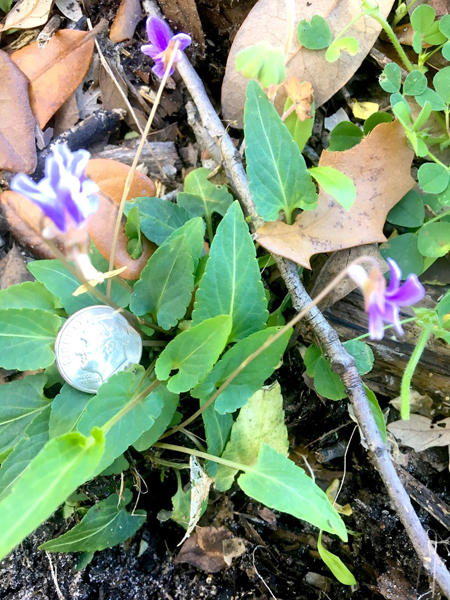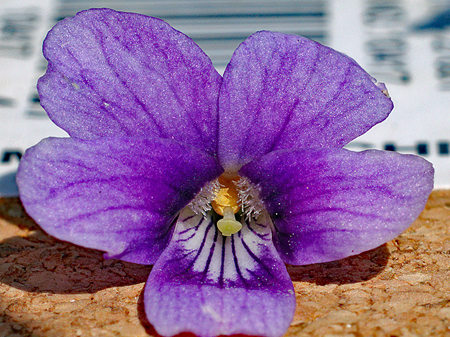Viola inconspicua Blume
Common names:
None in English.
Synonyms (incomplete):
Viola inconspicua Blume, Cat. Gew. Buitenzorg (Blume): 57. 1823
Description:
Acaulescent rosulate perennials from somewhat thick rhizome, ≤ 20 cm tall; foliage, peduncles and calyces green, proximal portion of petioles, peduncles and calyces finely spotted with reddish-purple, upper surface of leaf blades dark green, plant glabrous throughout; stipules adnate to petiole for up to 3/4 their length, fimbriate-dentate; leaves spreading to prostrate, leaf blades undivided, largest ≤ 90 × 70 mm, ovate-triangular, base shallowly to moderately deeply cordate, margins crenate, eciliate, apex acuminate; chasmogamous peduncle held above leaves; chasmogamous flower ≤ 12 mm; calyx glabrous, eciliate or ciliate; lowest sepals lanceolate to ovate-lanceolate, acuminate; auricles prominent and erose, not elongating in fruit; corolla pale blue to purple with proximal 1/2 of spurred petal white, throat white; spur cylindrical, 2&ndash4(4.5) mm, pale green spotted with reddish-purple; lateral petals densely bearded; chasmogamous capsule green, 8–10 mm; cleistogamous flowers produced after chasmogamous, cleistogamous capsule features not reported; seeds 1.0–1.5 × ca. 0.8 mm, deep green, unspotted; 2n=24, 48, 72.
Similar species:
This species and others most similar to it belong to the predominately Asian subsect. Patellares, which consists of acaulescent non-stoloniferous violets with stipules at least half-adnate to their petioles, somewhat to very elongate spurs, and mostly violet to purple corollas. Three species in the subsection that are introduced in our range, including this one, have leaf blades longer than broad. This species differs from V. japonica in its glabrous foliage, shorter spur, and densely bearded lateral petals. It is distinct from V. patrinii in lacking broad wings on the proportionally longer petioles, and in its violet to purple corolla.
Ecology:
In Asia, growing in grasslands, forest margins, fields and along paths (Chen et al. 2007); in North America, inhabiting nurseries, lawns and roadsides.
Distribution:
Temperate and tropical Asia; introduced and apparently naturalized in AL and FL (Loran Anderson pers. comm.), recently found in ME.
Rarity:
None.
Phenology:
Chasmogamous flower (in Asia) November–April, chasmogamous fruit December–May (September), cleistogamous fruit throughout the year(?).
Affinities:
This species belongs to sect. Plagiostigma Godron, subsect. Patellares (Boiss.) Rouy & Foucaud.
Hybrids:
None.
Comments:
Besides the species and their differences noted in the "Similar species" section, a third taxon of subsect. Patellares outside our range, V. philippica Cav. is not all that similar. That species has linear-lanceolate to lanceolate leaf blades cuneate to subtruncate at the base but glabrous lateral petals, has been reported from lawns, roadsides, and river bottoms in Kansas and Nebraska. The present Asian introduction was initially brought to my attention by Loran Anderson and Floyd Griffith in Florida; several other iNaturalist posts indicate that the violet has been spreading the Southeast as far as Texas. A recent iNaturalist post from Maine has been confirmed, where the species was found in mulch among nursery plants; in the short time since posting, the plants have already disappeared. Chen et al. (2007) suggest that the violet is somewhat weedy in its native range and often occupies lawns, roadsides, sidewalk cracks and other anthropogenic sites. The description was composed from images from a Florida population provided by Griffith and from Chen et al. (2007).
Literature Cited:
Chen, Y. S., Y. Quin-er, H. Ohba, and V. V. Nikitin. 2007. Violaceae. In Flora of China. Science Press, Beijing and Missouri Botanical Garden Press, St. Louis, Missouri, Vol. 13, pp. 74–111.

Chasmogamous flowering habit (plant at FL, Bay Co., Pitt and Sylvan Springs, March 2020) by Floyd Griffith

Leaves during chasmogamous flower by Loran Anderson

Chasmogamous flower front view (plant at FL, Bay Co., Pitt and Sylvan Springs, March 2020) by Floyd Griffith

Chasmogamous flower profile view (plant at FL, Bay Co., Pitt and Sylvan Springs, March 2020) by Floyd Griffith